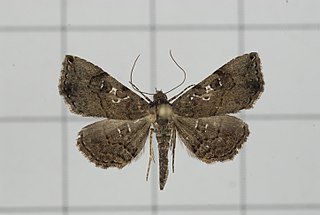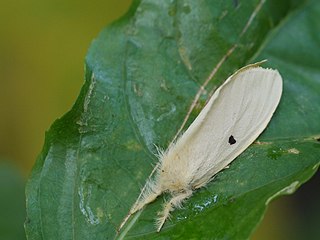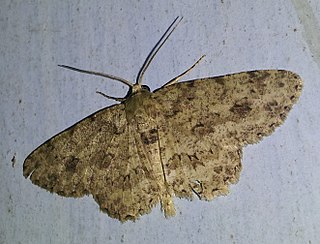
Euproctis is a genus of tussock moths in the family Erebidae described by Jacob Hübner in 1819. Species are cosmopolitan, widespread throughout Palearctic, African, Oriental and Australian regions. Molecular phylogenetic studies indicate that the genus as presently understood comprises a large number of unrelated lineages, only a few of which have names, and is therefore in serious need of revision.

Arctornis submarginata is a species of moth of the subfamily Lymantriinae of family Erebidae. It is found in the north-eastern Himalaya and Sikkim, Sri Lanka, on Borneo and Sumatra and in northern Australia.

Somena scintillans, the yellow tail tussock moth, is a moth in the family Erebidae described by Francis Walker in 1856. It is found in northern India, Sri Lanka, Myanmar and the Andaman Islands. Though considered a minor pest, larva can sporadically be a serious pest.
Cryptolechia is a genus of moths in the family Depressariidae.

Hyposidra talaca, the black looper or black inch worm, is a moth of the family Geometridae. The species was first described by Francis Walker in 1860. It is found from India to Indochina, Sundaland, Sulawesi, the Philippines, Sri Lanka, the Solomon Islands, Thailand, Taiwan, New Guinea and Australia, where it has been recorded from Queensland. It is a major defoliating pest in tea plantations.
Lenodora vittata is a moth of the family Lasiocampidae first described by Francis Walker in 1855. It is found in India and Sri Lanka.

Rhesala imparata is a moth of the family Erebidae first described by Francis Walker in 1865. It is sometimes referred to as an Albizia defoliator. It is found in Sri Lanka, India, Taiwan, Singapore and Borneo.
Artaxa angulata is a moth of the family Erebidae first described by Shōnen Matsumura in 1927. It is found in Taiwan, Myanmar, India, Pakistan, Sri Lanka, Malaysia, Singapore and Indonesia.
Artaxa guttata is a moth of the family Erebidae first described by Francis Walker in 1855. It is found in Bangladesh, Sri Lanka, and India.
Euproctis bimaculata is a moth of the family Erebidae first described by Francis Walker in 1855. It is found in India, Sri Lanka and Thailand.
Euproctis fraterna is a moth of the family Erebidae first described by Moore in 1883. It is found in the Maldives, India, Sri Lanka and the Seychelles.

Euproctis lunata, the castor hairy caterpillar, is a moth of the family Erebidae. The species was first described by Francis Walker in 1855. It is found in India, Pakistan, Sri Lanka and Thailand.
Euproctis semisignata is a moth of the family Erebidae first described by Francis Walker in 1865. It is found in India and Sri Lanka.

Euproctis varians is a moth of the family Erebidae first described by Francis Walker in 1855. It is found in India, Sri Lanka, the Maldives, Celebes and China.

Lymantria ampla is a moth of the family Erebidae first described by Francis Walker in 1855. It is found in India and Sri Lanka.
Lymantria marginata is a moth of the family Erebidae first described by Francis Walker in 1855. It is found in India, Bangladesh, Sri Lanka and Thailand.
Lymantria subrosea is a moth of the family Erebidae first described by Francis Walker in 1855. It is found from Sri Lanka to China and Sundaland, the Philippines, Sulawesi, Seram, the Lesser Sundas to Timor. The Sumatran population is categorized under the subspecies, Lymantria subrosea singapura.
Lymantria todara is a moth of the family Erebidae first described by Moore in 1879. It is found in India (Nilgiri) and Sri Lanka.

Ectropis bhurmitra, the tea twig caterpillar, is a moth of the family Geometridae. The species was first described by Francis Walker in 1860. A widespread Asian species, it is found around Indo-Australian tropics from India, Sri Lanka and Hong Kong, Taiwan, Thailand, New Guinea to Australian Queensland and the Solomon Islands.

Parasa bicolor, the green rice moth, is a moth of the family Limacodidae. The species was first described by Francis Walker in 1855. It is found in Sri Lanka, India, Nepal, Pakistan, Myanmar, Laos, Taiwan, Vietnam, Malaysia, Java, China and Taiwan.










